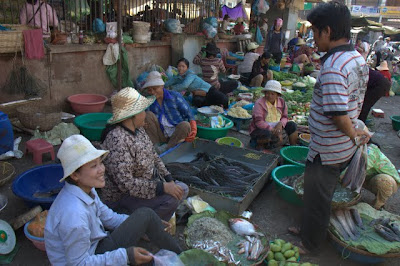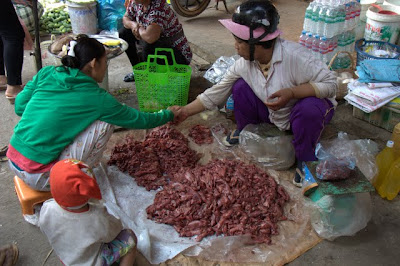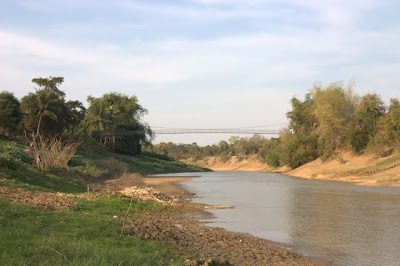Battambang: A Photo Essay
Since I just discovered how to make fancy black borders in WordPress, let’s get all fancy and call this a photo essay. Oooh.
Our time in Battambang was brief, but we fit in an awesome cooking class and an extensive tour of the surrounding countryside. Either one was worth the detour to Battambang alone.

Our first priority in Battambang was signing up for that evening's cooking class at the Smokin' Pot. I learned about the class over at Lives of Wander; Theresa's right, it is one of the best deals in Asia and I'm happy to report it is still only $8 for a hands on, three dish class with a trip to the market. And unlike our trip to the market during our Thai cooking class, we actually purchased the meat and produce we'd be using in our meals.

Which means the fish swimming around in buckets became the fish for our fish amok after this lady chopped off its head.

Carrying the kaffir lime leaves and still warm chicken meat. Thank goodness our classmates voted for breast.

Like Thai cooking, Cambodian meals often start with a paste of spices and herbs ground by a morter and pestle. We used half this paste in our fish amok and the other for the spicy beef stir-fry.

Sean is turning into quite the master chef during our Asian travels. In the pan, the coconut milk, curry paste, and fish simmer for the fish amok.

When the cooking instructor said spicy beef, he meant SPICY beef. This was easily the most spicy dish we had during our six months in Asia, requiring lots of rice and water to get it down. And it only had two or three chilies, plus the ones in the paste. Our instructor told us when he makes this dish at home, each family members customizes the dish to their liking. He takes 7 chillies, his wife takes 10, and his mother in law takes a whopping 13. Spicy!

The next morning, we set off on a tour of the countryside by tuk tuk, with Philay as our guide. We didn't so much meet Philay as Philay met us, being the most patient and persistent of the horde of tuk tuk drivers that swarmed us as we got off the bus in Battambang. Tuk-tuking tourists is big business in Battambang, particularly because there are a lot more tuk tuk drivers than there are tourists, and countryside tours are the biggest score of all.

Our first stop of the morning was to a local market, where we were the only non-Cambodians in sight. You might think we would get sick of markets but you would be wrong. Asian markets never disappoint; there's always something to watch, something more colorful and outrageous than the previous market. For example, the mouse transaction above. Yes, mice.

And you can't leave without a chili chopper, at least Philay didn't think so. After passing by the live chili chopping in action, the Cambodian version of an infomercial, Philay decided his wife would really like a chili chopper too.

After the market, we stopped by a former Pepsi plant. According to our guidebook, Pepsi abandoned the plant in the 70s when the Khmer Rouge rolled in. According to Philay, the plant was still in operation until the Vietnamese took over in the 80s. Either way, it stands as it did decades ago, with glass bottles collecting dust on the inside.

When going over the day's itinerary, Philay kept asking us if we wanted to see a coke-a-die farm. A coconut farm? we said. Yes, a coke-a-die farm, he repeated. Okay, we said. We like coconuts. When we arrived, Philay paid the attendant some riel and took us over to this water pit. Oh, we both said in unison. A crocodile farm! Yes, Philay said. Like I said, a coke-a-die farm.

When the government neglected public transport for the locals, the locals came up with their own method of transport: a bamboo train. The "train" is nothing more than a slab of bamboo strips set on top of wheels, running in between the real trains. Today, I'm pretty sure it exists pretty much as a tourist trap, but we allowed ourselves to fall into the trap and off we went.

...making hurtling forward on the tracks on the unattached bamboo an interesting ride to say the least.

And oh yeah, if someone is coming in the opposite direction? One of the bamboo trains has to move. We got the boot.

Next, we head to the riverfront, just as kids are on their way home from school and farmers finish their tasks in the late day sun.
We also do our good deed for the day; Philay stops to smoke some bats out of a tree next to a temple.

Philay seems very excited about our last stop - watching the sun set over a lotus farm - but we're a little rattled when we get there. Minutes before, on the big highway, we stopped at an accident scene that had happened right before we arrived. A man lays completely still on the side of the road. Philay learns a car ran him off his motorbike and he wasn't wearing a helmet. The lone Westerner at the scene is frantic. I can't get through to the police, he shouted, and half of this guy's head is gone! Philay agrees to drive to the police station to notify them. We start to take off when we hear sirens. Philay drives away without giving the accident a second thought. We, on the other hand, keep peppering him with questions. Cambodia has one of the highest traffic accident rates in the world; scenes like this are all too common. Unfortunately, because many people fail to wear their helmets, so are fatalities. Fines for driving without a helmet means you'll often see the male driver with a helmet, with female and child companions go without.

Philay was pleased when the lotus farm is teeming with bridal parties taking pictures. He'd been promising us weddings all day; we were never quite sure whether we were actually going to a wedding or just observing one. We're pleased we don't have to crash a wedding in our travel clothes. I pull myself together to resume my role as paparazzi. We learn Cambodian brides like big hair and big make-up on their wedding days, wear big colorful dresses that are the same color as the less ornate dresses worn by the bridesmaids, and decorate the cars in the same way Americans do.





